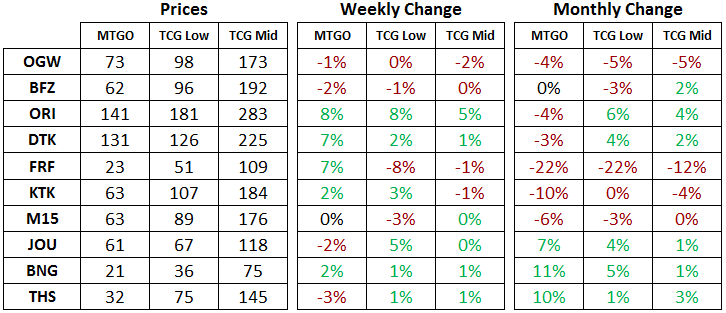Are you a Quiet Speculation member?
If not, now is a perfect time to join up! Our powerful tools, breaking-news analysis, and exclusive Discord channel will make sure you stay up to date and ahead of the curve.
Welcome to the MTGO Market Report as compiled by Matthew Lewis. The report will cover a range of topics, including a summary of set prices and price changes for redeemable sets, a look at the major trends in various constructed formats, and a "Trade of the Week" section that highlights a particular speculative strategy with an example and accompanying explanation.
As always, speculators should take into account their own budget, risk tolerance and current portfolio before buying or selling any digital objects. Questions will be answered and can be sent via private message or posted in the article comments.
Redemption
Below are the total set prices for all redeemable sets on MTGO. All prices are current as of April 4th, 2016. The TCG Low and TCG Mid prices are the sum of each set’s individual card prices on TCG Player, either the low price or the mid price respectively.
All MTGO set prices this week are taken from Goatbot’s website, and all weekly changes are now calculated relative to Goatbot’s ‘Full Set’ prices from the previous week. All monthly changes are also relative to the previous month prices, taken from Goatbot’s website at that time. Occasionally ‘Full Set’ prices are not available, and so estimated set prices are used instead.
Flashback Draft of the Week
Triple Coldsnap is the flashback draft this week, running April 6th through April 15th. Coldsnap was released as a "lost" set in the summer of 2006. Core sets at the time were being released every other year, so this set was released in the intervening year to fill the gap.
The "lost" gimmick was that Randy Buehler said the set was designed along with Ice Age and Alliances, but was put aside for the notoriously underpowered Homelands. Coldsnap was filed in away in a drawer and forgotten about. Mark Rosewater clarified later that the set was indeed a new design, and that supplied back story was just a ruse.
In any case, the set returns to Dominaria during the titular Ice Age and fleshes out the use of snow-covered lands and snow mana, as well as revisiting cumulative upkeep and pitch spells.
The expected value of Coldsnap boosters is high due to the presence of two valuable uncommons. Legacy staple Counterbalance currently goes for over 10 tix and the Modern playable Mishra's Bauble is over 5 tix at the moment. Also, snow-covered lands are common but can often get to 0.5 to 1.0 tix, so don't be afraid to stick these in your draft pile near the end of the pack even if you're not drafting a snow-related deck.
The ripple mechanic is something to watch out for in draft. Drafting one or two of the same ripple spell isn't a big deal, but if you start getting into three, four or five copies, then the impact can ramp up and be incredibly high.
Take, for example, Surging Dementia. On its own, this card is probably not worth playing. Forcing your opponent to discard one card of their choice for two mana is not playable in any draft format. But if you manage to draft a bunch of these "unplayable" cards, the possibility of chaining into multiples on turn two becomes very high.
Imagine having five copies of this spell in your deck. The chances of having it in your opening hand are very high, and then the chance of chaining into the others is also high. Your opponent just might have to recover from a two-mana Fugue (or worse) that you draw every game.
The ripple mechanic turns a bad spell into an efficient way to totally wreck your opponent's hand in the early game. It's a bad mechanic from a design perspective as multiple copies of a bad card can reduce variance while simultaneously increasing the impact of the spell. You have been warned!
Modern
If you missed the news, Eye of Ugin was banned while Ancestral Vision and Sword of the Meek were unbanned. Although the writing was on the wall for the Eldrazi-enabling land, the unbanning of the other two cards is a surprise and will shake up the format considerably.
It is pointless to try and predict what will happen and make speculative bets based on the prediction. The knee-jerk price reactions have already occurred and it would be prudent for players and speculators alike to sell into these price moves. Now is the time to be holding off on buying new cards until we have more information on the new Modern metagame and to make sure to stay liquid for Shadows over Innistrad (SOI) release events.
What interests me is the potential for Eldrazi decks to continue their level of play in Modern. Ancestral Vision is weak to Eldrazi processors, so it's possible that the more midrange, black-based Eldrazi archetype we saw in December returns. A hybrid Eldrazi Tron build is also still possible and has been showing results in the pre-ban Modern leagues.
Outside of Modern, Eye of Ugin will see play in Legacy Eldrazi builds, so stashing a few copies away for the future is a good long-term move while everyone is selling.
Standard
Unlike Modern, we are in a small window for buying future Standard staples from Battle for Zendikar (BFZ), Oath of the Gatewatch (OGW), Magic Origins (ORI) and Dragons of Tarkir (DTK). Once new results from the Star City Games Open Series and other big events start rolling in, the metagame will become more defined and the opportunity for big gains will disappear.
At the moment, there are a number of cards that are unplayable in Khans of Tarkir (KTK) Standard that will prove to be very useful in SOI Standard. Predicting which cards start seeing more play is tricky, but we can make some educated guesses.
My experience at the SOI prerelease is that Thalia's Lieutenant is a great card that pushes human tribal decks. Combined with Always Watching, white has access to two strong anthem effects in Standard as well as a powerful removal spell in Declaration in Stone. Melissa DeTora wrote about potential mono-white weenie decks featuring these cards over at TCG Player.
Two ORI cards that could slot into an aggressive white deck are Knight of the White Orchid and Kytheon, Hero of Akros. I put over 40 copies of Kytheon into the Market Report portfolio this morning as I have a hunch that white will be the colour of choice for aggressive decks at the start of this iteration of Standard.
Although Kytheon has more than doubled in the last month, going from 2 tix to over 4 tix, the price could be 7 to 10 tix quite quickly if white weenie shows up as a viable archetype this weekend.
Standard Boosters
There's not much to report on boosters this week as prices have been fairly stable. Look for a price drop on Fate Reforged and Khans of Tarkir boosters once SOI is released. BFZ and OGW boosters will also drop at that time and these will both eventually get back to 4 tix, a price level where DTK and ORI have consistently been hanging out.
Trade of the Week: Deciding to Sell
As usual, the portfolio is available at this link. Again I was focused on the price of Jace, Vryn's Prodigy from ORI as it jumped back up to over 80 tix. A 20 tix move up in just over a week is substantial, and this was almost the mirror of last week when it had dropped 20 tix in a week. With such a rapid recovery in price, it was time to reassess this trade.
When deciding to sell, there are a number of factors to consider, but the first thing to look at is the price history. At 80+ tix, Jace was back into its recent mid-to-high price range, with some possible further upside but now with some downside. There is no certainty that Jace will continue to hold its lofty price in SOI Standard, and until tournament results start coming in with the new cards from SOI, Jace at 80 tix is a lot riskier than Jace at 60 tix.
We are also heading into a new set release on MTGO, a time when tix are in high demand as players and bots scramble for new cards. Everyone is looking to sell old cards in order to buy new cards and to draft with the new set.
Selling cards during set releases is a bad idea from a top-down, financial perspective. Everyone needs tix, so if you are asking to exchange cards for tix you won't be getting full value for your cards. When a new set is released, you want to be the one with the tix, scooping up discounted cards. This is a big motivator for getting liquid and selling cards in the weeks ahead of any set release on MTGO.
Another signal which I like to look for is available supply. Similar to last week when I noticed supply of Jace was drying up around 60 tix, I noticed that the supply of Jace at 80 tix was starting to build. Along with a building supply was a growing spread between buy and sell prices.
When supply is tight, and the price is heading up, bots will be willing to lower their margins to keep cards in stock. But when a price peaks, the first price to drop will be the buy price. Once a card stops rising in price, a good operator will lower the buy price so as not to build up too much inventory at too high a price.
This combination of widening spreads and building supply was another indicator that it was time to sell.
Add it all up, and selling my copies of Jace was an easy decision. If Jace falls back to 60 tix or lower, then it will be time to think about buying again. By that time, we'll have more information on the state of Standard and whether or not Jace, Vryn's Prodigy maintains its viability in that format.
I love speculating on high-value mythic rares because the gross price swings can be large and the work of buying and selling them is small. It's also easy to pay very close attention to supply and bot margins.






Do you think Jace Vryns Prodigy will have long term value after its rotated out of standard? Should I buy my copies while they are at the lowish levels they are now or wait until rotation?
I think Jace will be cheapest at rotation in October, but I think we might see another dip below 60 tix during SOI release events.
If you want them to play Modern, and don’t mind waiting, then October will be the best price and lowest risk to buy Jace.
Great Thank You for the insight! As always great article and look forward to many more 🙂